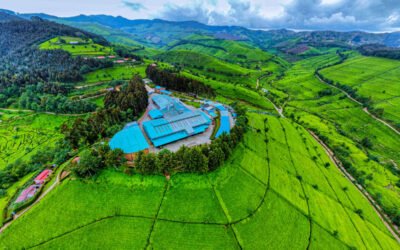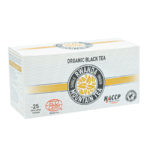Discover how Rwanda’s high-altitude tea plantations produce some of the world’s most exceptional teas through sustainable practices and meticulous craftsmanship.
The Perfect Growing Environment: Rwanda’s Tea Terroir
Nestled between 2,300 and 2,700 meters above sea level, Rwanda’s tea plantations benefit from what tea experts consider the perfect growing conditions. The country’s volcanic soils, consistent rainfall, and cool mountain climate create an ideal terroir for slow-growing, flavor-rich tea leaves.
Rwanda Mountain Tea Ltd (RMT) operates strategically located plantations across the northwestern and southwestern regions of Rwanda, covering an impressive 9,646 hectares. These renowned gardens – including Kitabi, Rubaya, Nyabihu, Gatare, Rutsiro, Mata, Nshili Kivu, Mushubi, and Gisakura – each contribute distinct characteristics to RMT’s exceptional teas.
“Rwanda’s high elevation slows the growth of tea bushes, allowing them to develop more complex flavors and higher concentrations of the compounds that give tea its distinctive taste,” explains Dr. Jane Nyirangarama, agricultural scientist at the University of Rwanda.
From Seedling to Mature Plant: The Cultivation Process
The journey begins with carefully selected seedlings from mother bushes known for their superior qualities. Tea plants require approximately 5 years to mature before they begin producing the tender leaves and buds ideal for harvesting.
RMT employs sustainable agricultural practices throughout this cultivation period:
- Organic fertilization methods that maintain soil health
- Integrated pest management to minimize chemical use
- Erosion control techniques vital for mountain terrain
- Water conservation systems
These practices have earned RMT multiple certifications, including ISO 22000:2018, Rainforest Alliance, ECOCERT, and HACCP, guaranteeing compliance with European (EOS) and American (NOP) standards.
The Art of Plucking: “Two Leaves and a Bud”
The harvesting process, known as “plucking,” requires skilled precision. RMT employs approximately 30,000 workers, two-thirds of whom are women, who carefully hand-harvest the “two leaves and a bud” formation from each tea plant.
This labor-intensive process ensures only the finest parts of the plant are selected. The elevation of Rwanda’s tea gardens means these leaves grow more slowly, developing higher concentrations of polyphenols and aromatic compounds than teas grown at lower elevations.
According to the Tea Research Foundation, tea grown above 2,000 meters contains up to 10% more flavor compounds than varieties grown at lower elevations.
Processing Methods: Creating Distinct Varieties
Once harvested, the leaves undergo specific processing techniques to create different tea varieties:
Black Tea Production
- Withering: Freshly plucked leaves are spread out to remove moisture (8-16 hours)
- Rolling: Leaves are rolled to break cell walls and release enzymes
- Oxidation: The rolled leaves oxidize, turning from green to copper-brown
- Firing: Heat is applied to stop oxidation and dry the leaves
Green Tea Production
- Steaming/Pan-firing: Heat is applied immediately to prevent oxidation
- Rolling: Leaves are shaped through rolling
- Drying: Final moisture reduction
This careful processing creates RMT’s distinctive grades, including BP (Broken Pekoe), FOP (Flowery Orange Pekoe), and FBOP (Flowery Broken Orange Pekoe), each with unique flavor profiles and brewing characteristics.
Quality Control: The Tasting Room
Before leaving the processing facility, each batch undergoes rigorous quality testing. Professional tea tasters, or “cuppers,” evaluate:
- Leaf appearance
- Liquor color
- Aroma complexity
- Flavor profile
- Mouthfeel
This meticulous quality control has helped Rwandan teas consistently win awards at prestigious international competitions like the Global Tea Championship and Great Taste Awards.
Global Recognition: Rwanda’s Tea on World Markets
Rwanda’s premium teas are now exported to Europe, Asia, and North America, with growing demand for the country’s distinctive flavor profiles. The ecological plantations at Rutsiro, Kitabi, and Gatare have gained particular international recognition for their exceptional quality.
According to the International Tea Committee, Rwanda ranks among the top 10 tea producers globally despite its small size, with quality consistently surpassing quantity in international markets.
Sustainability and Community Impact
The journey of Rwanda’s tea extends beyond production to create positive social impact:
- Infrastructure improvements including roads and clean water access
- Social programs providing healthcare and childcare facilities
- Housing for agricultural families
- Education support through initiatives like the GIRINKA program
As noted by the Sustainable Trade Initiative, “Rwanda’s tea industry represents one of Africa’s most successful models of agricultural development that balances economic growth with social equity.”
Future Innovations: Expanding Rwanda’s Tea Horizons
RMT continues to innovate, with plans to introduce specialty teas including white tea, pan-fired green tea, pearl tea, and matcha. These varieties aim to meet increasingly sophisticated global demand while maintaining Rwanda’s reputation for exceptional quality.
The company’s investment in developing new tea varieties and modern equipment ensures consistent superior quality, positioning Rwanda to remain competitive in the premium tea market for generations to come.
From Mountain to Cup: The Final Journey
After leaving Rwanda, these premium teas travel to markets worldwide, where consumers can finally experience the exceptional flavors cultivated through this meticulous journey.
Whether enjoying RMT’s organic black tea, orthodox varieties, or flavored blends like Tangawizi (ginger milk tea) or Lemongrass Tea, each cup represents a remarkable journey from Rwanda’s misty mountains to your teacup.
Experience Rwanda’s Premium Teas
Interested in experiencing these exceptional teas for yourself? Explore our complete product catalog or learn more about visiting our plantations to witness this remarkable journey firsthand.








